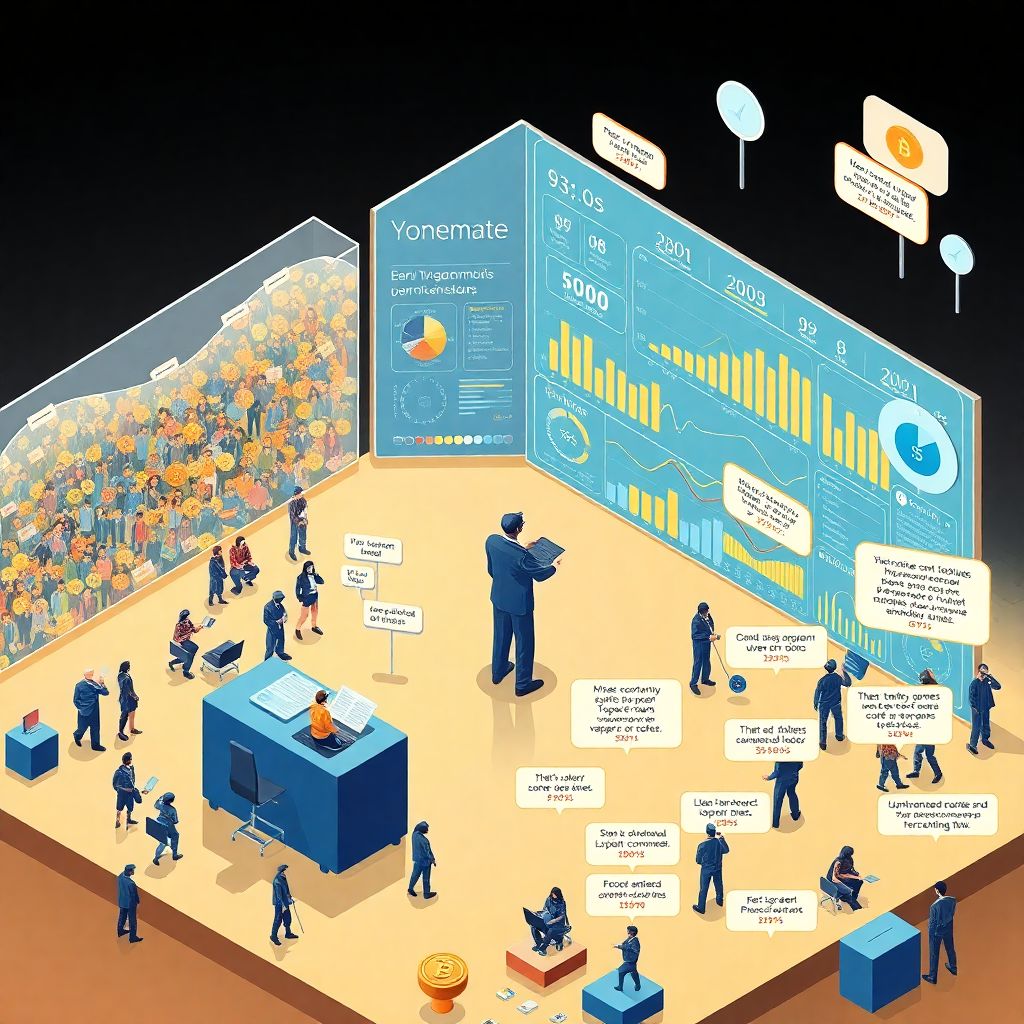Why community and developer metrics matter more than ever
Historical context: from cypherpunks to retail manias

Back in Bitcoin’s early days, “analysis” of a token mostly meant reading a mailing list and skimming Bitcointalk. Community health was trivial: a few dozen hardcore cypherpunks either hacked on the code or mined. As Ethereum arrived and ICOs exploded in 2017, liquidity outran fundamentals. Telegram groups with 100k bots pushed prices, while GitHub repos sat empty. Many retail newcomers didn’t yet know how to evaluate crypto project fundamentals beyond a flashy whitepaper and some memes.
The 2020–2021 DeFi and NFT wave forced the market to mature. Capital finally started paying for real usage, audited contracts and active contributors. Rug pulls and slow “vampire” exits, however, showed that surface-level hype still misleads. By 2025, serious participants use structured frameworks, crypto community analysis tools and on-chain analytics to separate organic ecosystems from manufactured noise. In that environment, ignoring community and developer activity is essentially trading blindfolded.
—
Evaluating community health
Key quantitative metrics you should track
When you look at a token today, start with measurable, repeatable signals. Think of them as telemetry for the social layer. Useful metrics include active users in official channels, engagement ratios on X, Discord and Farcaster, and the ratio of organic comments to obvious spam. You also want to see consistent growth in unique contributors to discussions, not just a small clique of maximalists dominating the narrative and drowning out critical feedback.
A basic set of crypto community analysis tools usually aggregates follower counts, engagement rates and sentiment. Treat raw follower numbers as vanity; focus instead on interaction depth: replies versus likes, share velocity around technical updates, and how many independent analysts or builders talk about the project without being on the payroll. Combining those with time-series views helps you see whether interest spikes are tied to real milestones or only to speculative news.
– Track weekly active members across at least two major channels
– Compare engagement per 1,000 followers over time
– Map how many unique handles show up around governance or technical threads
Qualitative signals: culture, governance and resilience
Numbers tell only half the story. Healthy communities show a culture of constructive disagreement, transparent governance and realistic expectations. Lurk in Discord or forums: do core team members answer technical questions, or is support outsourced to mods reading from scripts? Are roadmaps debated openly, or is any criticism labeled as “FUD” and quickly censored? These subtle cues often predict whether the ecosystem can adapt once market conditions shift.
Watch how the community behaves during drawdowns. In 2022 bear-market capitulation, projects with robust cultures saw contributors discussing protocol fees, treasury runway and UX improvements even as price fell. Weak ones devolved into price complaints and conspiracy theories. By 2025, governance channels on-chain and off-chain give you a forensic view of who actually wields power: whales, VCs, or a broad base of token holders willing to propose, debate and implement protocol changes.
– Read 2–3 long governance threads end-to-end
– Check how many proposals come from non-core-team wallets
– Note whether documentation and FAQs are maintained by the community
—
Evaluating developer activity
Repository-level metrics: what’s actually shipping
Developer activity is easier to measure, but it’s still nuanced. Raw commit counts can be gamed, so focus on patterns in the main repositories over time. Inspect issue velocity, pull-request frequency, code review quality and release cadence. A healthy project tends to have multiple maintainers, a clear contribution guide and tagged milestones that line up with public roadmaps rather than stealth pivots every few months.
The best platforms to track blockchain developer activity in 2025 usually combine GitHub and GitLab data, package manager downloads, vulnerability disclosures and even CI/CD logs. You want to see a stable or growing number of unique contributors, not just one overworked lead dev. Also check whether repositories are open by default, or if critical components remain closed-source; the latter raises questions for trust assumptions, security audits and long-term sustainability of the ecosystem.
On‑chain dev signals and protocol evolution

Code repositories are only one side: smart-contract deployments and upgrades provide ground truth. Active developer ecosystems show a steady flow of contract interactions, parameter updates, and new modules being permissionlessly built on top. Here, on-chain analytics tools for crypto research give you a complementary view: contracts deployed per month, unique deployers, upgrade frequency and governance execution of technical proposals.
Look for patterns like modular architectures that enable third-party extensions, or SDKs that lower the barrier for app developers. A project that encourages hackathons, publishes example dApps and maintains robust APIs usually sees more organic integrations. Conversely, ecosystems relying on one official front-end or a single market maker often stagnate once incentives dry up. By correlating repo activity with on-chain deployments, you can identify whether the codebase turns into production infrastructure or remains a perpetual “beta”.
—
Comparing approaches and toolsets
Off‑chain vs on‑chain analytics
There are two dominant lenses for assessing a token’s community and dev health: off-chain social data and on-chain behavioral data. Off-chain tools ingest X, Discord, Telegram and GitHub, then compute engagement and contribution metrics. They’re great for catching sentiment shifts, influencer campaigns and developer coordination. However, they suffer from noise: bots, fake followers, and private repos all distort the picture more than people expect at first glance.
On-chain approaches focus on addresses, transactions, contract calls and token flows. They’re harder to manipulate at scale and map closer to actual usage. The downside is that they miss the “why” behind activity: you can see that a governance contract executed votes, but not whether those proposals got debated thoughtfully or rubber-stamped. A balanced workflow blends both: off-chain data for narrative context and on-chain traces for verifiable behavior, especially when you evaluate upgrades and treasury spending over multi-year cycles.
Automation vs manual review
Many investors lean heavily on dashboards, but full automation hides critical nuance. Quantitative systems detect anomalies quickly—sudden surges in social mentions or GitHub commits—but they can’t judge code quality or community ethos. Manual code review and forum reading are slower, yet they filter out performative updates and marketing campaigns designed purely to tick metrics boxes for quarterly reports.
As a rule of thumb, use automated pipelines for broad screening and historical baselining, then manual deep dives for high-conviction positions. Automation shines for scanning hundreds of tokens; human judgment is essential once treasury exposure, protocol dependencies or large user bases are involved. Over the last few market cycles, the best outcomes tended to come from hybrid approaches that treat tools as decision-support systems rather than oracles dictating buy/sell signals.
– Use dashboards to flag anomalies and shortlist projects
– Manually review code, docs and governance for shortlisted tokens
– Revisit assumptions every 3–6 months as ecosystems evolve
—
Practical recommendations and workflows
Building a community and dev‑focused checklist
To operationalize all this, fold these ideas into a structured crypto due diligence checklist for investors. Start with community: multi-channel presence, engagement depth, governance participation and resilience during volatility. Then move to development: open-source posture, contributor diversity, release discipline, audits and bug-bounty activity. Finally, tie these inputs to token design—does value actually accrue to the asset you’re analyzing, or only to underlying infrastructure players?
When deciding how to evaluate crypto project fundamentals, explicitly document each dimension: team, tech, traction, tokenomics and transparency. Under “tech” and “traction,” log both repo metrics and on-chain signals, plus the social fabric supporting them. Over time, this creates a feedback loop: you can look back and see which early warning signs you ignored for past failures, or which strengths you correctly identified for successful long-term holds across multiple market cycles.
Recommended tools and 2025 workflow
By 2025, a typical evaluation stack combines social listening, repository analytics and protocol-level dashboards. For community, mix native platform analytics with specialized crypto community analysis tools that de-duplicate bots and score organic engagement. For development, aggregator services that monitor multiple repos, languages and package registries give you a more precise picture than raw GitHub stars. Together, they help you quickly isolate ecosystems where builders and users still show up in a bear market.
On the research side, on-chain analytics tools for crypto research are now tightly integrated into portfolio systems, letting you overlay address-level data with governance and dev events. A good baseline workflow is: screen with dashboards, dive into forums and repos, cross-check with contract and treasury movements, and only then look at price. This order reverses the 2017–2021 pattern, where price action led research. The projects most likely to survive the next cycle are those where the social layer and codebase reinforce each other, not just the chart.

